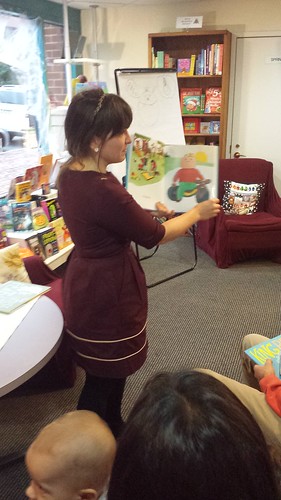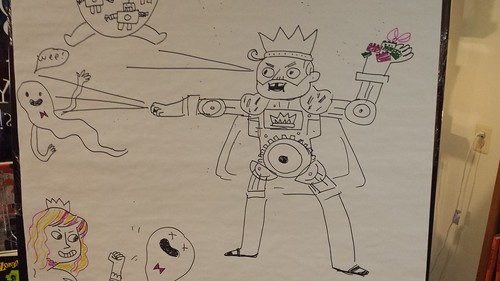This weekend children's book writer Steve Metzger came to Alexandria to do a reading and signing at Hooray for Books. The book is for young readers - I was definitely the oldest person sitting in the crowd as he read from two of his picture books, and then an abridged version of the entire The Bumble Brothers: Crazy for Comics. I enjoyed chatting with him and asked him to do a interview. You can sign up for his newsletter at this link.
What type of comic work or cartooning do you do?
I'm a writer of graphic novels for 8-11 year olds.
Why is Bumble Brothers a graphic novel? Why is it your
first one?
The Bumble Brothers is a graphic novel because I want it to
excite "reluctant readers" about reading. If you're 8 or 9 years old
and you're not reading, you're in trouble. The humor that I liked when I was 9
years old is humor I still enjoy. It's my first one because all of the prior
books that I authored were picture books. I was ready to move on to graphic
novels.
How did you find an artist to work with on it?
 When my daughter was 4 years old, she really enjoyed the
illustrations of a beginning reader book called, "Two Crazy Pigs." I
never forgot Brian Schatell's illustrations and when I started looking for an
illustrator for the Bumble Brothers, I contacted him.
When my daughter was 4 years old, she really enjoyed the
illustrations of a beginning reader book called, "Two Crazy Pigs." I
never forgot Brian Schatell's illustrations and when I started looking for an
illustrator for the Bumble Brothers, I contacted him.
How long did the book take from start to finish? There's
going to be more than 1 published?
From start to finish, this book took about one year. It took
about 3 months for me to write and revise the script; it then took Brian almost
a year to do the illustrations. It took about longer for him because he has a
full-time job. There are going to be three books in the series.
How do you do it? Traditional pen and ink, computer or a
combination? (i.e., do you just write a script, or do thumbnails, or lay it all
out w/ descriptions of what should be happening in each panel)
I'm not sure what Brian's process is when he does his
amazing illustrations. I give him a script which includes approximately 230
panels. This seems to be a good number for a 96-page graphic novel.
When (within a decade is fine) and where were you born?
I was born in NYC in 1949. I spent the first 20 years of my
life in Queens.
What area do you live in? Why were you visiting
Washington now?
I now live in the upper westside of Manhattan. I was
visiting the Washington area (Alexandria, VA) because I was invited to read the
Bumble Brothers at "Hooray for Books," a terrific bookstore run by
Ellen Klein.
What is your training and/or education in writing
children's books?
Most of my earlier books are picture books and I guess a lot
my training for writing for young children came from my teaching experiences.
Who are your influences?
My favorite children's authors and illustrators are: Leo
Lionni, Ezra Jack Keats, John Steptoe, Lewis Carroll, Tedd Arnold, and Maurice
Sendak. The Bumble Brothers' book is filled with silliness; my comedic
influences (especially from when I was young) are: Abbott and Costello, the
Marx Brothers, Lucille Ball, Stan Freberg, Charlie Chaplin, Carol Burnett, Bob
and Ray, Jerry Lewis, Steve Allen, Jackie Gleason, Laurel and Hardy, Allan
Sherman, Sid Caesar, and Jack Benny.
If you could, what in your career would you do-over or change?
That's a tough one. I spent a lot of time in dead-end jobs,
e.g., dishwasher and taxi driver. Perhaps it would have been better for me if I
did something else during those years, but I really didn't know what I wanted
to do. Looking back, every job I've ever had kinda prepared me for the next
one.
What work are you best-known for?
I think the most popular book of mine is a picture book:
"We're Going on a Leaf Hunt." Based on the song, "We're Going on
a Bear Hunt," it didn't take a long time to write and it's a perennial
bestseller in autumn.
What work are you most proud of?
I'm most proud of my collaboration with Tedd Arnold on our
picture book, "Detective Blue." I love his illustrations and I like
the idea of a noir Mother Goose mystery filled with nursery rhyme characters.
 What would you like to do or work on in the future?
What would you like to do or work on in the future?
If it's possible, I'd like to continue writing more Bumble
Brothers' books. #2, "The Bumble Brothers: The Not-So-Secret
Clubhouse" is coming out in Fall 2023 and #3, "Frabbit: The Birth of
a Superhero" will be out in 2024.
What do you do when you're in a rut or have writer's
block?
When I have writer's block, I don't force it. A bike ride
around Central Park often does the trick of clearing my head and gets me going
again.
What do you think will be the future of your field?
There seems to be a big growth spurt in all kinds of graphic
novels. I think this will continue until there's saturation.
What comic books or graphic novels do you read regularly
or recommend?
I enjoy reading other humorous graphic novels, like Big Nate, Action Presidents, InvestiGATORS, Max Meow, and The Bad Guys. In a more serious vein, I also enjoy these graphic novels: American Born Chinese, This One Summer, and Blankets.
 What's your favorite thing about DC?
What's your favorite thing about DC?
Least favorite?
Living in New York City, I am well aware about the problems
of homelessness. Still, I wish there weren't so many homeless in the DC area.
Also, the heat and humidity in the summer months.
What monument or museum do you like to visit?
While in Alexandria, I enjoyed my visit to Mount Vernon -- a
fascinating place! When I visit Washington DC, I really like visiting the
Lincoln Memorial, the Vietnam Veterans Memorial, and the National Museum of
African American History and Culture.
 Do you have a website or blog?
Do you have a website or blog?
http://www.stevemetzgerbooks.com
How has the COVID-19 outbreak affected you, personally
and professionally?
Personally, I was saddened by the death of a close friend’s
relative. Professionally, I was lucky to have met my agent right before the
outbreak of COVID-19. Since I write from home, I wasn't that affected on a
day-to-day basis.




























